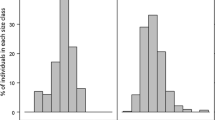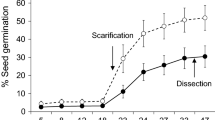Summary
Emergence and survival of honey mesquite (Prosopis glandulosa var.glandulosa Torr.) seedlings was quantified on sites with contrasting grazing histories: long-term continuous grazing (LTG) and long-term protection (LTP) from grazing by cattle. On each site, different levels of heroaceous defoliation were imposed at monthly intervals (no defoliation=ND, moderate=MD and heavy=HD). The two weeks following seed dissemination appeared to be the most critical toProsopis establishment on LTP-ND plots. Openings in the herbaceous layer created by moderate defoliation of grasses on the LTP site increased germination and/or survival 7-to 8-fold during this period. However, increasing the degree of defoliation from moderate to heavy did not stimulate additional emergence on either the LTP or LTG site. Emergence from scarified seed placed in cattle dung (17 to 30%) was lower than that of bare seed placements in various microhabitats (43–60%). However, deposition of scarifiedProsopis seed in dung in conjunction with graminoid defoliation may be the most likely combination of events when livestock are present. Emergence from seeds transported into grasslands by other fauna likely would be low, unless seeds were deposited in areas where grasses had been defoliated.Prosopis survival was comparably high in dung and bare seed placements after one growing season. survival of seedlings present two weeks after seed dissemination ranged from 74 to 97% at the end of the second growing season. Seedling survival and shoot development (biomass, leaf area and height) were similar on LTP and LTG sites, regardless of the level of herbaceous defoliation or seed placement. In addition, the magnitude and patterns of net photosynthesis, stomatal conductance and xylem water potential were comparable among one-year-old seedtings on ND, MD and HD plots, even though differences in herbaceous species composition and above- and below-ground biomass between these treatments were substantial. Such data suggest competition for soil resources between grasses andProsopis may be minimal early in the life cycle ofProsopis. High rates ofProsopis emergence and establishment on LTP-MD plots are counter to the widespread assumption that long-term and/or heavy grazing is requisite forProsopis encroachment into grasslands. Results are discussed with regard to factors contributing to the recent, widespread invasion of this woody legume into grasslands of southwestern North America.
Similar content being viewed by others
Abbreviations
- LTG:
-
long-term grazed
- LTP:
-
long-term protected from grazing
- ND:
-
non-defoliated
- MD:
-
moderate defoliation
- HD:
-
heavy defoliation
References
Archer S (1989) Have Southern Texas savannas been converted to woodlands in recent history? Am Nat (in press)
Archer S, Scifres CJ, Bassham CR and Maggio R (1988) Autogenic succession in a subtropical savanna: conversion of grassland to a thorn woodland. Ecological Monogr 58:111–127
Archer S, Tieszen LL (1983) Effects of simulated grazing on foliage and root production and biomass allocation in an artic tundra sedge (Eriophorum vaginatum). Oecologia 58:92–102
Auken OW van, Bush JK (1987) Influence of plant density on the growth ofProsopis glandulosa var.glandulosa andBuchloe dactyloides. Bull Torrey Bot Club 114:393–401
Auken OW van, Bush JK (1988) Competition betweenSchizachyrium scoparium andProsopis glandulosa. Am J Bot 75:782–789
Axelrod DL (1937) A Pliocene flora from the Mt. Eden beds, southern California. Carnegie Inst. Washington Publ 476:125–183
Brown AL (1950) Shrub invasion of southern Arizona grasslands. J Range Manage 3:172–177
Brown JR, Archer S (1987) Woody plant seed dispersal and gap formation in a North American subtropical savanna woodland: the role of domestic herbivores. Vegetatio 73:73–80
Bogusch ER (1952) Brush invasion on the Rio Grande Plains of Texas. Texas J Sci 4:85–91
Buffington LC, Herbel CH (1965) Vegetational changes on a semidesert grassland range from 1858 to 1963. Ecol Monogr 35:139–164
Caldwell MM, Richards JH, Manwaring JH and Eissenstat DM (1987) Rapid shifts in phosphate acquisition show direct competition between neighboring plants. Nature 327:615–616
Carmen JG, Briske DD (1982) Root initiation and root and leaf elongation of dependent little bluestem tillers following defoliation. Agron J 74:432–435
Correll DS, Johnston MC (1979) Manual of the vascular plants of Texas. Univ. Texas at Dallas, Richardson, TX. p 1881
Daubenmire R (1959) A canopy cover method of vegetational analysis. Northwest Sci 33:43–64
Eissenstat DM, Caldwell MM (1988) Competitive ability is linked to rates of water extraction: a field study of two arid-land tussock grasses. Oecologia 75:1–7
Eissenstat DM, Mitchell JE (1983) Effects of seeding grass and clover on growth and water potential of Douglas fir seedlings. For Sci 29:166–179
Glendening GE, Paulsen HA (1955) Reproduction and establishment of velvet mesquite as related to invasion of semi-desert grasslands. USDA For Serv Tech Bull 1127
Goldberg DA, Werner PA (1983) Effects of size of opening in vegetation and litter cover on seedling establishment of goldenrod. Oecologia 60:149–155
Griffiths JF (1981) The climate of Bryan-College Station, Texas. Office of the State Climatologist, Dept. Meteorology, Texas A&M Univ., College Station
Hester TR (1980) Digging into south Texas prehistory. Corona Publ Co, San Antonio. p 201
Hastings JR, Turner RM (1965) The changing mile: an ecological study of vegetation change with time in the lower mile of an arid and semi-arid region. Univ Arizona Press, Tucson
Humphrey RR (1958) The desert grassland: a history of vegetational change and an analysis of causes. Bot Rev 24:193–252
Humphrey RR, Mehroff LA (1958) Vegetation changes on Arizona grassland ranges. Ecology 39:720–726
Janzen DH (1982) Removal of seeds from horse dung by tropical rodents: influence of habitat and amount of dung. Ecology 63:1887–1990
Janzen DH (1986) Chihuahuan Desert nopaleras: defaunated big mammal vegetation. Ann Rev Ecol Syst 17:595–636
Johnston MC (1963) Past and present grasslands of southern Texas and northeastern Mexico. Ecology 44:456–466
Keppel G (1982) Design and analysis: A researcher's handbook. Prentice-Hall, Englewood Cliff, NJ
Knapp AK, Seastedt JR (1986) Detritus accumulation limits productivity of tallgrass prairie. BioScience 36:662–668
Knoop WT, Walker BH (1985) Interactions of woody and herbaceous vegetation in a southern African savanna. J Ecol 73:235–253
Launchbaugh JL (1955) Vegetational changes in the San Antonio prairie associated with grazing, retirement from grazing and abandonment from cultivation. Ecol Monogr 25:39–57
Lehman VW (1969) Forgotten legions: sheep in the Rio Grande Plains of Texas. Texas Western Univ Press, Univ Texas, El Paso. p 226
Madany MH, West NE (1983) Livestock grazing-fire regime interactions within montane forests of Zion National Park, Utah. Ecology 64:661–667
Martin PS (1967) Prehistoric overkill. In: Martin PS, Wright HE (eds) Pleistocene extinctions: the search for a cause. Yale Univ Press, New Haven, pp 75–120
Meyer RE, Bovey RW (1982) Establishment of honey mesquite and huisache on a native pasture. J Range Manage 35:548–550
Mooney HA, Simpson BB, Solbrig OT (1977) Phenology, morphology and physiology, pp 26–42. In: Simpson BB (ed) Mesquite: its biology in two desert ecosystems. US/IBP Synthesis Series Vol. 4. Dowden, Hutchinson, & Ross, Inc, Stroudsberg, Pa
Neilson RP (1986) High resolution climatic analysis and southwest biogeography. Science 232:27–34
Peet RK (1974) The measurement of species diversity. Ann Rev Ecol Syst 5:285–307
Rummel RS (1951) Some effects of livestock grazing on ponderosa pine forests and range in central Washington. Ecology 32:594–607
Sands R, Sandian-Nambier EK (1984) Water relations ofPinus radiata in competition with weeds. Can J For Res 14:233–237
Sariano A, Sala O (1983) Ecological strategies in a Patagonian steppe. Vegetatio 56:9–15
Scholander PF, Hammel HT, Bradstreet ED, Hemmingsen EA (1965) Sap pressure in vascular plants. Science 148:339–345
Scifres CJ, Brock JH (1969) Moisture-temperature interelations in germination and early seedling development of mesquite. J Range Manage 22:334–337
Scifres CJ, Brock JH (1971) Thermal regulation of water uptake by germinating honey mesquite seeds. J Range Manage 24:157–158
Scifres CJ, Kienart CR, Elrod DJ (1973) Honey mesquite seedling growth and 2,4,5-T susceptibility as influenced by shading. J Range Manage 26:58–60
Smith DA, Schmutz EM (1975) Vegetative changes on protected versus grazed desert grassland ranges in Arizona. J Range Manage 28:453–457
Ueckert DN, Smith LL, Allen BL (1979) Emergence and survival of honey mesquite seedlings on several soils in west Texas. J Range Manage 32:284–287
Walker BH, Ludwig D, Holling CS, Peterman RM (1981) Stability of semi-arid savannah grazing systems. J Ecol 69:473–498
Weeda WC (1967) The effects of cattle dung patches on pasture growth, botanical composition and pasture utilization. New Zealand J Agr Res 10:150–159
Wright HA, Bunting SC, Neuenschwander LF (1976) Effect of fire on honey mesquite. J Range Manage 29:467–471
Author information
Authors and Affiliations
Rights and permissions
About this article
Cite this article
Brown, J.R., Archer, S. Woody plant invasion of grasslands: establishment of honey mesquite (Prosopis glandulosa var.glandulosa) on sites differing in herbaceous biomass and grazing history. Oecologia 80, 19–26 (1989). https://doi.org/10.1007/BF00789926
Received:
Published:
Issue Date:
DOI: https://doi.org/10.1007/BF00789926




